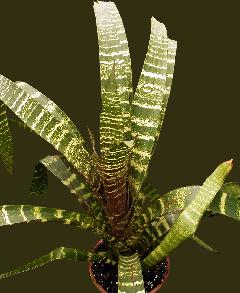
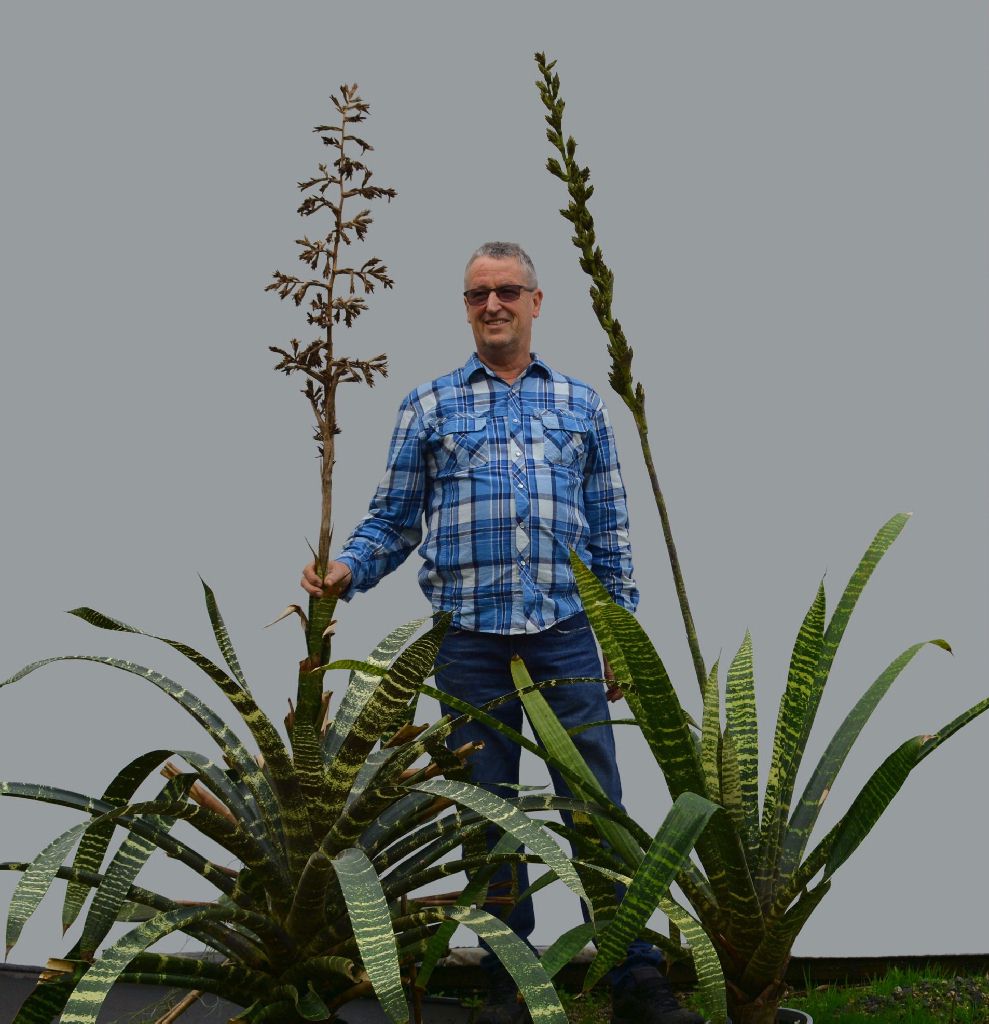
The description of G. bismarckii is now synonymous with G. lindenii. So therefore G. bismarckii does not exist.
So the plant we grew for the past 40-50 years as G. lindenii has now been described as G. vonbismarckii.
So on Bromeliads in Australia:
1. My photos of G. bismarckii are actually G. lindenii.
2. My photo of G. lindenii is G. vonbismarckii.
3. Allan Ladds G. lindenii is G. vonbismarckii.
4. G. bismarckii does not exist anymore.
5. It is G. vonbismarckii on the left & G. lindenii of the right – with me in the middle.
6. The Hohenbergia drawing is mis-filed.
The photo captions on this site have now been modified for lindenii, bismarkii and vonbismarkii pages.
Now vonbismarckii |
Chris Larson 08/18 Now vonbismarckii left, lindenii right |
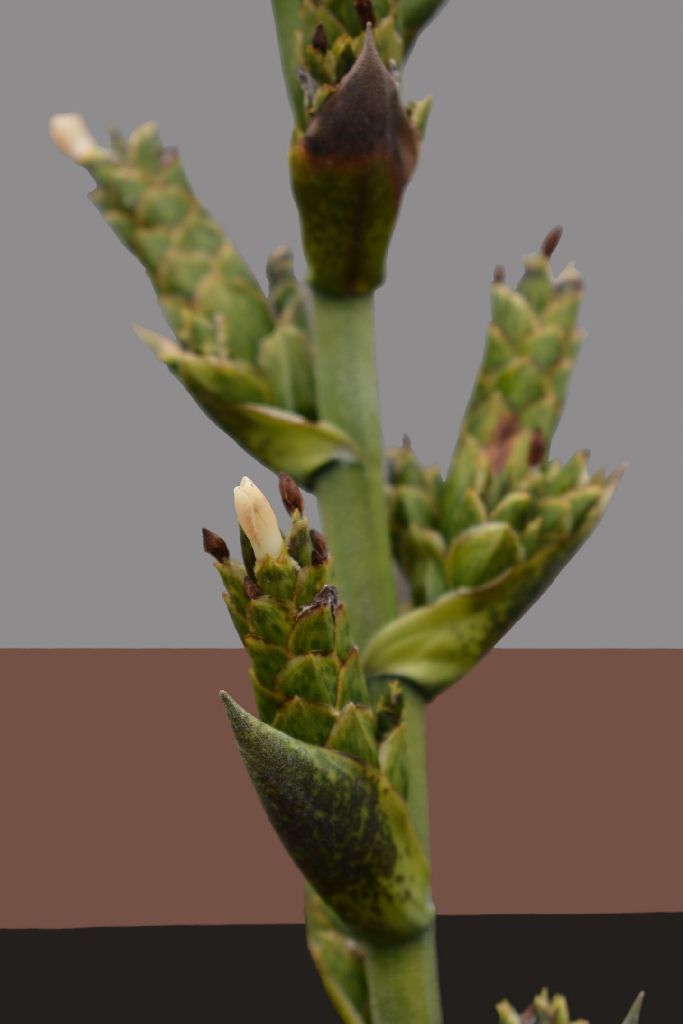
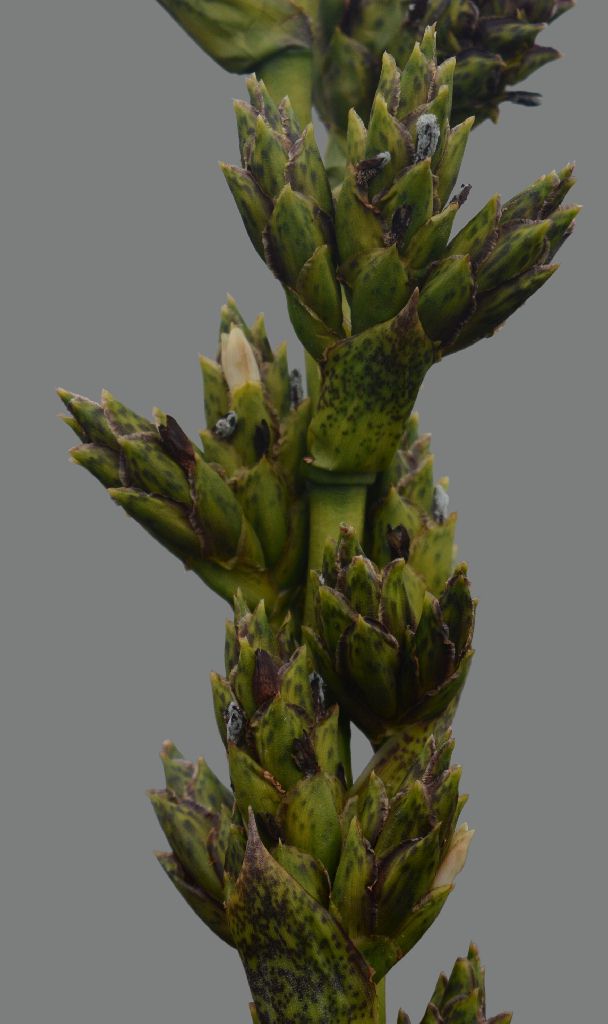
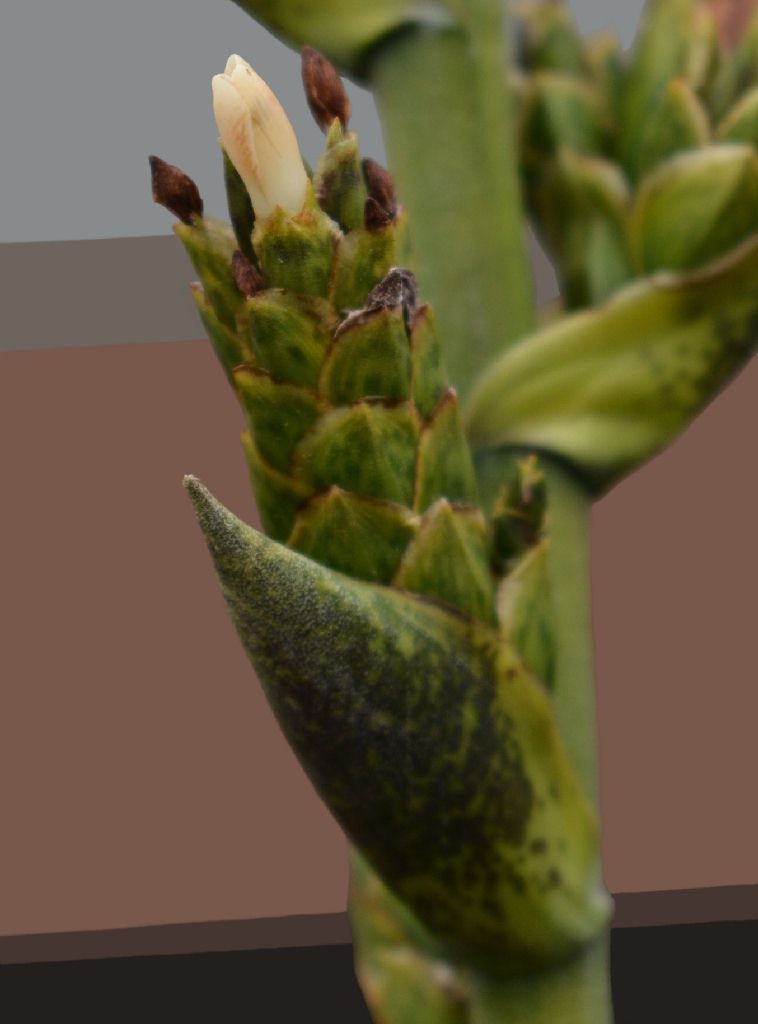
Now lindenii |
Guzmania lindenii (ANDRE) MEZ var. concolor RAUH, Trop. Subtrop. Pflanzenwelt. 43:41-46. 1983
On numerous trips, with Klaus von BISMARCK, Lima (Peru), in Chanchomayotal (Dptm). Junin, we found in July 1967 G. lindenii, which until then the exact location was unknown. The statement in L. B. SMITH, Flora Neotropica 14/2, 1317,1977, is: "Northern Peru, without locality". We collected some with very decorative leaf markings, that are found in almost all collections today. We also found a large funnel shaped Guzmania that had only weakly marked leaves, that we initially thought was a new species but because G. lindenii was nearby, considered it to be a variety of G. lindenii, because of the few banded leaves, should be described as concolor.
The two varieties are lindenii and concolor:
Guzmania lindenii (Andre) Mez (DC). Monogr. Phan. 9,333, 1896, var. lindenii
Leaves in a large funnel-rosette. Leaf blades alternately with yellowish-white narrower and wider and dark green cross-stripes; later with reddish brown hieroglyphic-type cross-lines. Inflorescence laxly tripinnate, with horizontal sticking out side branches. Primary bracts longer than the short, 1.5 cm long, stem-like basal section. Floral bracts broad oval, rounded, mainly green, violet spotted and violet edged.
Type: Germiny hortus s. n.,( Holotype LG); North-Peru without exact location
Habitat and range: Epiphytic in the mountain-forest, between San Ramon and Oxapampa, 1200 m, Dptm. Junin, Rauh and Bismarck 21092, July 1967.
The plant is common in the same area.
Guzmania lindenii (ANDRE) MEZ var. concolor RAUH var. nov.
A varietate lindenio differt characteribus sequentibus: laminae tantum iuventute lineis transversis rufis hieroglyphicis, senectute fere evanescentibus, laminae veteres itaque concolores. Inflorescentiae laxissime bi-vel tripinnatae. Rami primi ordinis pauciramosi, arcuatoadscendentes parte basali longissima sterili; spicae subdensae longiores et laxiores quam in var. lindenio. Bracteae florales angustae lanceolatae longiores vel breviores quam sepala; rhachis spicarum visibilis.
Differs from the var. lindenii in following characteristics:
Leaf blades only in the youth densely with reddish-brown, hieroglyphic-like cross-lines, which in age virtually vanishing; old blades therefore almost monochrome. Inflorescence very laxly bi to tripinnate. Primary side-branches small, bending erect, with very long, sterile basal section; Spikes lax, longer and more lax than the var. lindenii. Floral bracts narrow-lanceolate, longer to shorter than the sepals; Spike rhachis visible.
Plant stemless, flowering to 1.4 m high.
Leaves numerous, forming a broadly funnel-shape, 25-40 cm high, 90-100 cm wide rosette.
Sheaths indistinct, to 18 cm long and 7 cm wide, both sides dense light brown scaled, underneath at the base dark-chestnut brown.
Blades ligulate, tapering to a 0.5 cm long tip, to 8.5 cm wide, upper side dark, underneath light green, both sides glabrous, with very fine, only visible underneath, darker, hieroglyphic-like cross-lines; young leaves clear.
Scape erect, 1 cm thick, 60-70 cm long, green, glabrous, smooth, grooved when dry.
Scape bracts adjacent to the base of the scape, densely imbricate, longer than the internodes, with long sheath and short, adjacent to the scape, triangular blade, glabrous to scattered scales, at the base almost black, normally dark wine-red stained and hieroglyphic lined.
Inflorescence very loosely bi- to tripinnate, in the shape of a pyramid, including the end spike to 80 cm long and to 40 cm wide, with about 11 horizontal sticking out or bent upwards, to 20 cm long primary side branches.
Inflorescence rhachis round, 0.7 cm thick, black-green, smooth, (drying grooved).
Primary bracts long-triangular-acuminate, shorter than the to 7-15 cm long,
sterile basal portion of the spike, green, violet dots. The flattened spike stem with a 2 keeled, sloping peduncle bract, inserted about 2 cm high; after the seat the base of the spike are 1-3 sterile, floral bracts. Fertile section of the spike to 11 cm (Secondary spike to 5 cm) long, thin, cylindric, 1.5 cm wide, with numerous, spiral-shaped, somewhat lax, erect bracts; the green, glabrous, angular, excavated spike rhachis visible.
Flowers to 2.8 cm long, subsessile.
Floral bracts almost upright, longlish-lanceolate, acuminate, to 20 mm long and 7 mm wide, glabrous, green, at the tip scattered lepidote, with violet, hyaline edge, a little longer than the sepals;
Sepals green, shiny, glabrous, with hyaline, violet edge, connate unequally high, (about 3 mm), very scattered lepidote.
Petals 2.8 cm long, with free, spreading, about egg-shaped, cream, to 1 cm long plattes.
Stamens with the anthers a little shorter than the petals.
Style somewhat shorter than the anthers.
Ovary 3-angular, smooth, 3 mm high.
Nught flowerer..
Holotype: Rauh and von Bismarck 31312, 7.7.77, in the Herb. Inst. Syst. Bot. Univ. Heidelberg (HEID).
Habitat and range: Epiphytic, in the mountain-forest between San Ramon and Oxapampa (Dptm). Junin, 1200 m, together with var. lindenii.
The plant was also collected under Rauh and von Bismarck 31 764, (10.8.77).
The var. concolor is less attractive than the var. lindenii. It is worth mentioning that the leaves in culture after some years almost lose their crossbands and virtually become chloroplast free, becoming a greenish white colour.
Notable Leaf Markings in Guzmanias by Werner Motschenbach in J Brom. Soc. 38(5):216-9. 1988
Bromeliads have become more and more popular in the last few decades. The new cultivars in particular catch our eye with their interesting inflorescences and their splendidly colored spikes and bring a breath of the tropics to any winter garden or window sill. In addition, we have the tremendously long durability of the blooming plant and the rich selection of species and varieties.
One group of the family, from which I would like to introduce a few representatives, gains the admiration of the observer by its especially beautiful leaf markings. Even in their non-blooming state, color-tinged bands, hieroglyphic like stripes, and irregular patterns on the leaves, combined with the geometrical rosette growth habit, make these bromeliads the gems of the plant kingdom. As in other plant families, it is often noted that plants distinguished by special leaf coloration possess plain-looking inflorescences. Guzmania lindenii Mez is in this category. The leaves, which are up to 70 cm long, form a funnel-shaped rosette. They are brown at the base and yellow-green with dark green to brownish green bands of reticulated markings in the upper portion. In cultivation, we have observed that the leaves become yellowish rather quickly and the zoning becomes weak and irregular; the beauty is thus lost. This phenomenon has always been attributed to too much light.
I am of the opinion, however, that in collections in which all the plants are grown much the same there is too little attention given to the required cloud-forest conditions. We have kept Guzmania lindenii in various climatic conditions and have thus been able to determine that in a cooler location the loss of chlorophyll is considerably less (figures 11 and 12).
Although Andre described this species as Massangea lindeni in 1878, the precise habitat was not known. Professor Werner Rauh along with Klaus von Bismarck then found Guzmania lindenii in Peru in July of 1967 growing epiphytically in the mountain forest at a height of 1,200 meters. It is also known to grow in the Chanchamayo Valley up to 2,500 m.
We soon got seed from the Botanical Garden at Heidelberg and managed to create a nice stand of them in the Palmengarten {in Frankfurt am Main}. Although the plants are healthy, we are still waiting for a bloom even though in the winter of 1985-1986 we lowered the temperature for one part of them to stimulate flower formation. In November 1985, we treated one plant with 6 cm of a 2.5 % solution of Ethrel poured into the funnel. Ethrel is a liquid chemical that is used today in many commercial nurseries to control and hasten the bloom period of bromeliads. If one follows the precise instructions, it is effective not only in funnel-shaped bromeliads but good results have also been accomplished in epiphytic tillandsias, even in cases in which the grower had waited over ten years for an obviously mature plant to bloom.
A plant hobbyist who is growing just a few bromeliads presumably will not readily buy Ethrel, especially since it is available only in large amounts with the commercial grower in mind. I would, therefore, like to mention another, simpler method that can be used with equally good results. The bromeliad that one wants to force into bloom and which is also in generally good condition is enclosed in a clear plastic bag along with a big, ripe apple. The bromeliad and the apple are kept in the bag for about three weeks. The ethylene gas released in small amounts by the apple also has a bloom-promoting effect.
In the case of the plant that we treated, the first phase of the development of a bloom spike was visible after just eight weeks. Growth proceeded uninterruptedly and by October the panicle-like inflorescence was already about 1.10 m tall. In November and December growth stopped. My colleague gave up hope that flowers would still develop. The hibernation, however, did not last long, and in January 1987 the flowers did indeed appear - white and unassuming, night-time flowers, as in many other guzmanias, that are closed come daybreak. We carefully watched the appearance of the flowers and pollinated them first thing in the morning. Now we are hoping for seed.
In 1983, Professor Rauh described a variety that he had collected with Mr. von Bismarck in the distribution area of Guzmania lindenii. This plant remains smaller. The leaves reach to 50 cm and only in their juvenile stage have dense reddish-brown hieroglyphics in diagonal lines, which nearly disappear with maturity. In so doing, the plant appears to be one solid color, thus leading to the name G. lindenii Mez var. concolor Rauh. This variety is less attractive but blooms quite readily. It has bloomed several times already for us, but it has not formed seed.
The third type in this series, and in my opinion the most interesting and most impressive, is Guzmania bismarckii Rauh. This species was discovered in 1980 by Professor Rauh and Klaus von Bismarck in northeast Peru where it grows at a height of 800 m in the deep shadows of the humid, hot, rain forest on swampy, sandy soil. G. bismarckii was described in 1984 as a new species by Professor Rauh and was named after KIaus von Bismarck who has accompanied him on many collection trips.
Although Guzmania bismarckii can be categorized with G. lindenii, there are, nevertheless, basic differences especially in the nonblooming stage such as, for example, the stiff, upright funnel rosette which can attain a height of 1.5 m and a diameter of over 1 m. When in bloom the plant reaches up to 2.5 m! In addition, in G. bismarckii the leaf markings stay; in cultivation there is no loss of chlorophyll as in G. lindenii. Also G. bismarckii, in contrast with G. lindenii, is found growing as a terrestrial.
The plants that Professor Rauh collected for the Palmengarten have also kept their splendid markings. They have become larger and more beautiful in the three years and I hope that I shall yet see a bloom.
As smaller representatives of this series I would like to introduce two other species, which are good in the home in a sunny window or in a special plant area. Guzmania musaica Mez comes from Panama and Colombia where it grows epiphytically in mangrove swamps and in the rain forests of the plain up to an altitude of 500 m. The reddish orange inflorescence has a dense head, is very attractive, and lasts for a long time, which makes the plant especially to be recommended.
More delicate and graceful, but also more demanding in regard to higher humidity, is Guzmania vittata Mez. It comes from Colombia and Brazil where it grows as an epiphyte at altitudes of 200 to 500 m. The inflorescence, however, is not as striking as in G. musaica. The beauty of this species lies especially in the elegance of the leaves with their lovely markings.
Reprinted from Der Palmengarten 2/87.-84-87. By permission. Translated by Harvey L. Kendall